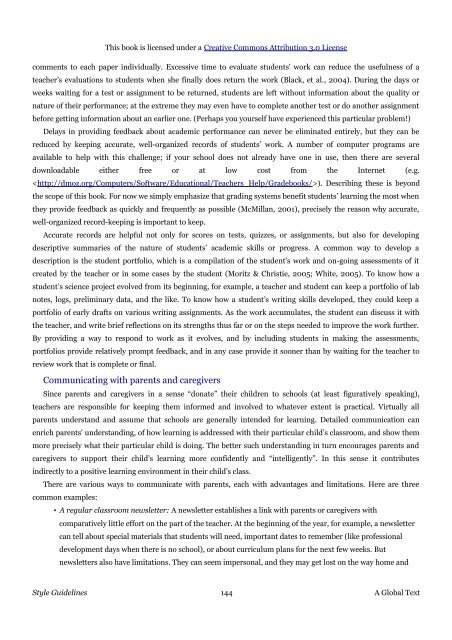Educational Psychology Third Edition Kelvin Seifert and Rosemary ...
Educational Psychology Third Edition Kelvin Seifert and Rosemary ...
Educational Psychology Third Edition Kelvin Seifert and Rosemary ...
You also want an ePaper? Increase the reach of your titles
YUMPU automatically turns print PDFs into web optimized ePapers that Google loves.
This book is licensed under a Creative Commons Attribution 3.0 License<br />
comments to each paper individually. Excessive time to evaluate students' work can reduce the usefulness of a<br />
teacher’s evaluations to students when she finally does return the work (Black, et al., 2004). During the days or<br />
weeks waiting for a test or assignment to be returned, students are left without information about the quality or<br />
nature of their performance; at the extreme they may even have to complete another test or do another assignment<br />
before getting information about an earlier one. (Perhaps you yourself have experienced this particular problem!)<br />
Delays in providing feedback about academic performance can never be eliminated entirely, but they can be<br />
reduced by keeping accurate, well-organized records of students’ work. A number of computer programs are<br />
available to help with this challenge; if your school does not already have one in use, then there are several<br />
downloadable either free or at low cost from the Internet (e.g.<br />
). Describing these is beyond<br />
the scope of this book. For now we simply emphasize that grading systems benefit students’ learning the most when<br />
they provide feedback as quickly <strong>and</strong> frequently as possible (McMillan, 2001), precisely the reason why accurate,<br />
well-organized record-keeping is important to keep.<br />
Accurate records are helpful not only for scores on tests, quizzes, or assignments, but also for developing<br />
descriptive summaries of the nature of students’ academic skills or progress. A common way to develop a<br />
description is the student portfolio, which is a compilation of the student’s work <strong>and</strong> on-going assessments of it<br />
created by the teacher or in some cases by the student (Moritz & Christie, 2005; White, 2005). To know how a<br />
student’s science project evolved from its beginning, for example, a teacher <strong>and</strong> student can keep a portfolio of lab<br />
notes, logs, preliminary data, <strong>and</strong> the like. To know how a student’s writing skills developed, they could keep a<br />
portfolio of early drafts on various writing assignments. As the work accumulates, the student can discuss it with<br />
the teacher, <strong>and</strong> write brief reflections on its strengths thus far or on the steps needed to improve the work further.<br />
By providing a way to respond to work as it evolves, <strong>and</strong> by including students in making the assessments,<br />
portfolios provide relatively prompt feedback, <strong>and</strong> in any case provide it sooner than by waiting for the teacher to<br />
review work that is complete or final.<br />
Communicating with parents <strong>and</strong> caregivers<br />
Since parents <strong>and</strong> caregivers in a sense “donate” their children to schools (at least figuratively speaking),<br />
teachers are responsible for keeping them informed <strong>and</strong> involved to whatever extent is practical. Virtually all<br />
parents underst<strong>and</strong> <strong>and</strong> assume that schools are generally intended for learning. Detailed communication can<br />
enrich parents' underst<strong>and</strong>ing, of how learning is addressed with their particular child’s classroom, <strong>and</strong> show them<br />
more precisely what their particular child is doing. The better such underst<strong>and</strong>ing in turn encourages parents <strong>and</strong><br />
caregivers to support their child’s learning more confidently <strong>and</strong> “intelligently”. In this sense it contributes<br />
indirectly to a positive learning environment in their child’s class.<br />
There are various ways to communicate with parents, each with advantages <strong>and</strong> limitations. Here are three<br />
common examples:<br />
• A regular classroom newsletter: A newsletter establishes a link with parents or caregivers with<br />
comparatively little effort on the part of the teacher. At the beginning of the year, for example, a newsletter<br />
can tell about special materials that students will need, important dates to remember (like professional<br />
development days when there is no school), or about curriculum plans for the next few weeks. But<br />
newsletters also have limitations. They can seem impersonal, <strong>and</strong> they may get lost on the way home <strong>and</strong><br />
Style Guidelines 144 A Global Text


